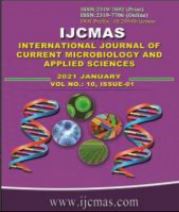


 National Academy of Agricultural Sciences (NAAS)
National Academy of Agricultural Sciences (NAAS)

|
PRINT ISSN : 2319-7692
Online ISSN : 2319-7706 Issues : 12 per year Publisher : Excellent Publishers Email : editorijcmas@gmail.com / submit@ijcmas.com Editor-in-chief: Dr.M.Prakash Index Copernicus ICV 2018: 95.39 NAAS RATING 2020: 5.38 |
The experiment was conducted to analyse the effect of herbicides on soil microflora and Dehydrogenase activity in transplanted Bt cotton based intercropping system during 2018-19 and 2019-20, at Agricultural Research Station, Malnoor, University of Agricultural Sciences, Raichur, Karnataka. The soil of the experimental field was medium deep black with clay loam texture, slightly high in pH (8.14), normal EC (0.35 dS m-1), medium in OC (0.56 %), available nitrogen (344 kg ha-1), phosphorus (29.21 kg ha-1) and high in available potassium (355 kg ha-1). The treatments consisted of four cropping systems in main plots and five weed control treatments in sub plots and were replicated thrice in a split plot design. The data indicated that pre emergence application of pendimethalin 38.7 CS @ 0.34 kg a.i. ha-1 or oxadiargyl @ 0.04 kg a.i. ha-1 reduced the microbial population (Bacteria, Fungi and Actinomycetes) and Dehydrogenase enzyme activity significantly over the treatments where no herbicides were applied (unweeded check, weed free, hand weeding). While the values were on par at 60 DAS and at harvest which indicated that the herbicide effect did not persist for longer time as the herbicides degraded in soil by microbes as the herbicides were used as the carbon source for multiplication. The seed cotton equivalent yield was higher when herbicides were used, indicating that no adverse effect of the herbicide.
 |
 |
 |
 |
 |